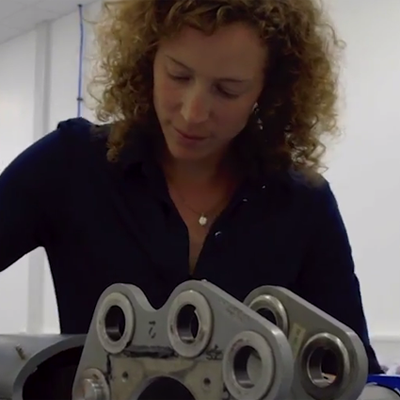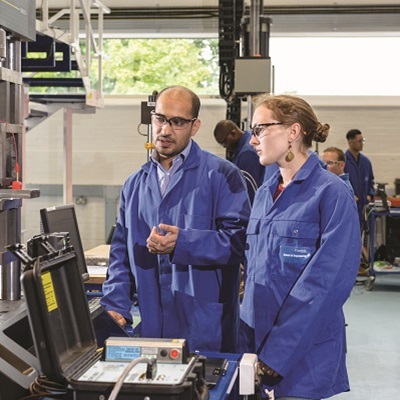What is an apprenticeship?
An apprenticeship is a job with an accompanying skills development programme; it combines educational learning with workplace training and learning. An apprenticeship should be the most appropriate learning programme for the individual and must be for either: a new job that requires new knowledge and skills, or an existing job which requires significant new knowledge, skills and behaviours (KSBs).
As an apprenticeship combines educational learning with workplace training and learning, the demands on an apprentice are significantly different to if you were to undertake a more traditional postgraduate course or programme. Your employer will be heavily involved in your apprenticeship and will undertake activities such as regular reviews, as well as mentoring and providing opportunities to apply newfound knowledge and skills within your organisation.
As an apprentice, you are required to spend a minimum of 6 hours per week on average during your apprenticeship, on off-the-job activities that directly that directly relate to your apprenticeship. The off-the-job activity cannot be part of your usual work, however, your employer can utilise some of this time by deploying you to undertake projects within the organisation, so long as it would not part of your normal role.
It's important to note that an apprenticeship is not solely an academic programme; the academic programme and corresponding qualification is just one element of an apprenticeship. There are different and additional commitments and expectations required of both you and your employer.
Apprenticeship standards and assessment plans
Apprenticeship standard
An apprenticeship is aligned to a standard which is referred to as an ‘apprenticeship standard’. Apprenticeship standards are designed by industry and lay out which KSBs must be mastered by you by the end of your apprenticeship in order to successfully achieve the apprenticeship qualification.
An apprenticeship standard is designed by groups of employers known as ‘trailblazer groups’ to meet skill shortages in their sectors and is linked to an occupational profile.
The academic element of the apprenticeship programme is mapped to the apprenticeship standard.
Note: The standard shown below is the Senior Leader standard, for illustration purposes.

Assessment plans
To successfully complete your apprenticeship, you will need to achieve a pass, merit, and/or distinction in the End Point Assessment (EPA), during which your competence of the KSBs, as set out in the apprenticeship standard, are assessed. The EPA plan is a document which was created by the trailblazer group which sets out the requirements, assessment methods and grading criteria for the EPA. All current apprenticeship standards and assessment plans can be found on the Institute for Apprenticeships website.
Your apprenticeship journey
As explained, your degree apprenticeship combines academic and vocational learning, which together provide a basis from which you can develop, refine and apply the KSBs learnt as part of your apprenticeship.
You will capture and record reflective and progressive learning and understanding throughout your apprenticeship in your structured portfolio workbook.
As you can see in the infographic below, your degree apprenticeship is a continual process of gaining knowledge and skills from your course and applying what you have learned in your workplace. You will be expected to reflect on and record these experiences which will allow you to understand and record which competencies (KSBs) have been met. You will also be expected to record your off-the-job activity and regular progress reviews which should be held with someone in your company, usually your line manager. Cranfield refer to this person as your reviewer. Supporting and underpinning these activities is your portfolio.
By the end of the on-programme phase of your apprenticeship, you will have produced a portfolio of evidence showing how you have applied your newly learnt KSBs in a real work environment to achieve real work objectives. The portfolio will form the basis of the professional discussion with the independent assessor during your End Point Assessment (EPA).
The EPA plan for the Senior Leader Level 7 standard can be found below, as an example.

English and maths requirements
Apprentices on level 7 apprenticeships in England are required to provide evidence of attainment in English and maths in the form of an accepted qualification at level 2 or above. Apprentices are also required to evidence their current woking level, this is achieved through an online maths and English assessment during the application process. This is a statutory requirement stipulated by the Education and Skills Funding Agency (ESFA) for all apprentices in England on apprenticeships which are level 3 or above.
This is not an entry requirement to the apprenticeship, however, apprentices without a level 2 English and maths qualification will need to achieve this prior to taking the End Point Assessment (EPA). Cranfield will support apprentices to achieve this.
You can see the list of acceptable qualifications and equivalents by visiting the UK Government's website and opening the document entitled ‘Apprenticeship standards: list of acceptable current and prior qualifications for English and maths requirements in apprenticeship standards at level 2 and above’. Please ensure you select the ‘Level 3 Apprenticeships’ tab for the correct list of acceptable qualifications. If your qualification is not listed, unfortunately it will not be accepted by the EPA organisation at gateway.
Answers to some frequently asked questions can be found below or, if further information is required, please contact the Apprenticeships Office .
Higher level qualifications
English and maths are accepted at a higher level – for example, a degree or A levels – providing that it has 'English' and/or 'maths' in the title of the qualification, and/or maths is the predominant element of the qualification (for maths). Other higher qualifications which do not meet this requirement will not be accepted, for example, MSc Engineering etc.
Don't have an English or maths qualification?
You can still enrol on the apprenticeship if you do not currently hold a level 2 English and maths qualification. The easiest way to meet this requirement if you do not already hold one of the accepted qualifications, or one of the qualifications at the necessary grade, is to sit a functional skills level 2 test in English and/or maths. We will support you in completing this whilst you undertake your apprenticeship.
Missing certificates?
Please contact your school and/or examining body to request a copy of your certificates if you cannot locate them. Your school should be able to provide you with information on which examining body they used if you cannot remember. Please be aware, if you cannot track down acceptable evidence, you will be required to complete an English and/or maths qualification (functional skills) in order to be able to provide proof.
Overseas qualifications
If you studied overseas, ESFA have deemed that your qualifications will be acceptable where there is clear evidence, from NARIC, via a certificate/statement of comparability, that the qualification is an equivalent level to the minimum requirements for English and maths; the comparability statement must include information that confirms the qualification is an equivalent of GCSE English and/or maths (A* to C).
NARIC is the UK’s national agency responsible for providing information and opinion on academic, vocational and professional qualifications from across the world. ESFA have directed that the acceptable route for achieving statements of comparability is through NARIC only. NARIC only provide a comparison of your qualifications and cannot comment if they will be deemed acceptable for the apprenticeship requirements. Please visit the NARIC website for further information and to request a certificate/statement of comparability confirming English and maths qualifications held are equivalent to GCSE English and/or maths (A* to C). Please note that the ESFA have stipulated that for overseas English qualifications to be accepted, English needs to be the first language.
What is acceptable evidence?
Acceptable evidence is a full certificate or e-certificate, a statement of results issued by an awarding organisation, a screenshot of the awarding organisation’s system showing the qualification has been achieved/awarded, or a copy of the personal learner record. You can see the list of acceptable qualifications and equivalents by visiting the UK Government's website and opening the document entitled ‘Apprenticeship standards: list of acceptable current and prior qualifications for English and maths requirements in apprenticeship standards at level 2 and above’. Please ensure you select the ‘Level 3 Apprenticeships’ tab for the correct list of acceptable qualifications. If your qualification is not listed, unfortunately it will not be accepted by the EPA organisation at gateway.
How do I provide proof?
You will be asked to provide evidence at the Initial Assessment stage. If you are not able to locate evidence at this time, you can submit documents at a later stage to apprenticeships@cranfield.ac.uk.







